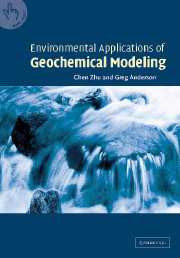Book contents
- Frontmatter
- Contents
- Preface
- 1 Introduction
- 2 Model Concepts
- 3 Thermodynamic Background
- 4 Computer Programs for Geochemical Modeling
- 5 Preparation and Construction of a Geochemical Model
- 6 Speciation and Solubility Modeling
- 7 Modeling Surface Adsorption
- 8 Reaction Path Modeling
- 9 Inverse Mass Balance Modeling
- 10 Coupled Reactive Transport Models
- 11 Kinetics Modeling
- Appendix
- References
- Index
9 - Inverse Mass Balance Modeling
Published online by Cambridge University Press: 27 March 2010
- Frontmatter
- Contents
- Preface
- 1 Introduction
- 2 Model Concepts
- 3 Thermodynamic Background
- 4 Computer Programs for Geochemical Modeling
- 5 Preparation and Construction of a Geochemical Model
- 6 Speciation and Solubility Modeling
- 7 Modeling Surface Adsorption
- 8 Reaction Path Modeling
- 9 Inverse Mass Balance Modeling
- 10 Coupled Reactive Transport Models
- 11 Kinetics Modeling
- Appendix
- References
- Index
Summary
Introduction
Garrels and Mackenzie (1967) introduced inverse mass balance modeling into geochemistry. They showed that if the chemistry of the start and end solutions are known, possible mass transfer reactions that had produced the compositional differences and the extent to which these reactions had taken place could be deduced from the mass balance principle.
Plummer and co-workers (Plummer, 1985; Plummer et al., 1983, 1990, 1991, 1994; Wigley et al., 1978) used this concept to model groundwater aquifers, and greatly expanded and formalized this approach. Their main interest was to deduce the mass transfer reactions taking place between two observation points along a flow path, which may have been responsible for the chemical and isotopic evolution of the groundwater. Mass transfer here refers to simple mass transfer between two or more phases, such as dissolution and precipitation of minerals (e.g., Nordstrom and Munoz, 1985). The development of the program netpath by Plummer and co-workers (Plummer et al., 1991, 1994) has greatly facilitated the use of this modeling approach. Recent development of a new version of phreeqc by David Parkhurst (Parkhurst, 1995, 1997) incorporates uncertainty analysis and a more complete set of mass balance constraints, reaching a new level of model sophistication.
We omit the mathematical development here. Serious modelers should read Parkhurst (1997), Plummer et al. (1991, 1994), and Wigley et al. (1978). Readers are also encouraged to read very carefully the work by Plummer et al. (1990) on the Madison aquifer, Montana, which demonstrates splendidly the application of inverse mass balance modeling in a regional aquifer.
Information
- Type
- Chapter
- Information
- Environmental Applications of Geochemical Modeling , pp. 180 - 198Publisher: Cambridge University PressPrint publication year: 2002
